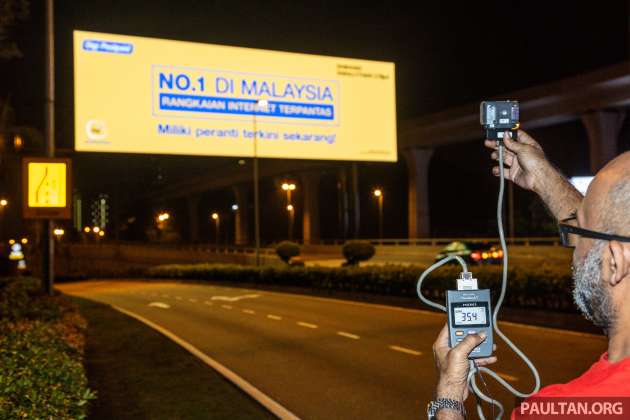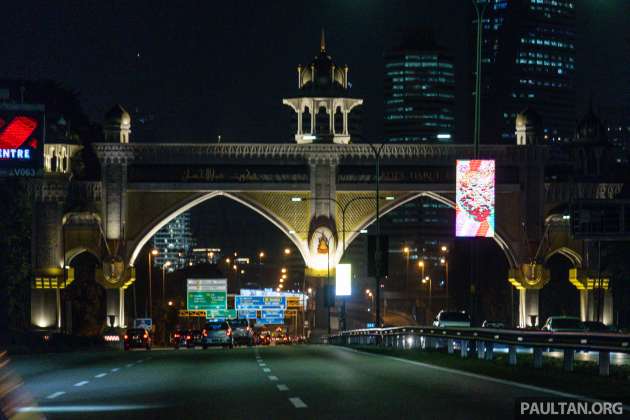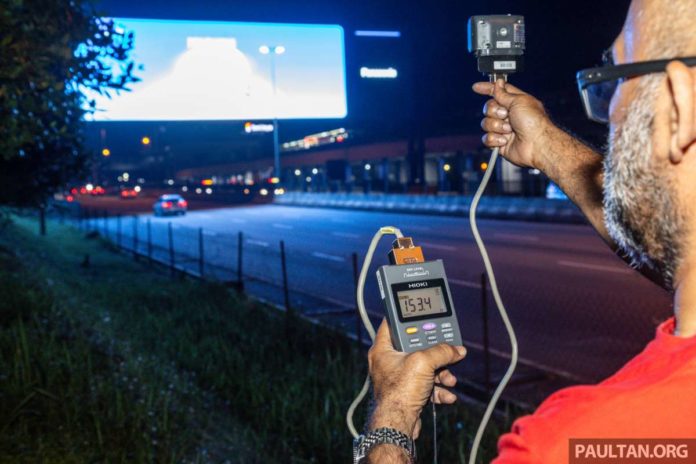It’s happened to all of us, you’re driving along a highway or main road in the city at night, and suddenly you’re blinded by a blaze of light. No, Putin hasn’t pushed the button and that’s not a nuclear bomb flash, you’re looking at an electronic billboard – a giant display screen playing ads on loop.
Ubiquitous on Malaysian roads in the Klang Valley, electronic billboards are a form of revenue for the highway concessionaire. Stuck in traffic jams as most drivers are, advertisers have a captive audience for as long as the car takes to shuffle past.
But do electronic billboards pose a hazard to driving, especially at night and in rainy conditions when the diffusion caused by raindrops intensifies the glare? To this end, paultan.org set out to find if electronic billboards are in fact too bright at night and pose a distraction to driving.
First, what do the regulations say?


For Malaysia, outdoor billboard advertising is governed by the Local Government Act 1976 and the Street, Drainage and Building Act 1974, along with relevant by-laws and regulations in the district council. Regulations state electronic billboards are only allowed to be active between 6.00 am and 1.00 am daily.
Additionally, there is a restriction for how bright a billboard is allowed to be at night, with the degree of luminescence measured by a lux meter. From the Public Works Department (JKR) listing for billboard brightness, the regulations are based on criteria issued by the UK Institution of Lighting Engineers with approval for the signboard coming from both JKR and TNB.
In the measuring criteria, it is stated an electronic LED billboard or display can have a maximum permissible luminance of 600 cd/m2 at night for an illuminated area of less than 10 square meters, and 300 cd/m2 for billboards measuring over 10 square meters. The numbers drop to 400 cd/m2 and 200 cd/m2 respectively at night for billboards larger than 10 square meters on rural roads. Anyway, the important number for us here is 300 cd/m2 for large billboards, within city limits.
How do we measure “brightness”?

If you’re wondering what the units mean, cd/m2 is candela steradian per square metre, defined as a unit of illuminance and luminous emittance. For the purpose of our study, we used a calibrated lux meter, which measures illuminance in lux or lumen per square metre, and by fortuitous coincidence, one cd/m2 is equivalent to one lux. For easier understanding, we will be using cd/m2 from this point on, as per the legal limits.
Thus suitably equipped, paultan.org set out on the roads and highways of Kuala Lumpur, Petaling Jaya and the Federal Highway, stopping at selected locations where an electronic billboard was casting its light on the road. Since the measurements were taken at midnight, stray illumination from other sources, such as car headlights or buildings, was kept to a minimum while ambient conditions were slightly cloudy.
Readings were taken from five locations – on the LDP at Kelana Jaya station eastbound, on Jalan Maarof at Bangsar Village as well as at Bangsar Shopping Centre, on the Sprint Highway at the Section 17 intersection and at the Sheraton Petaling Jaya on Jalan Utara. Measurement specs call for readings to be taken a metre away, but as we don’t have access to do so, our readings were taken from a standing position as close as we could get to the billboard, typically around 20 to 30 metres away.
Actual findings – brighter than our future!

In Bangsar, readings of 170 and 207 cd/m2 were taken for Bangsar at Bangsar Village and Jalan Maarof, respectively. During measurement, it was noticed the colour and graphics displayed on screen had a significant impact on the light reading (white-based ads give higher numbers) and we opted to only record the maximum value during testing.
At the Sprint Section 17 intersection, a maximum value of 184 cd/m2 was recorded. It must be noted while the reading fell just inside the regulations, standing in front of the billboard as the brightest advertisements were displayed was enough to send Patrick’s, our photographer, camera metering into spasms.
The physical effect was almost bright enough to hurt and very much an annoyance at best. However, these are subjective perceptions and will differ from person to person. Or, as Patrick said, “maybe old people see the light differently.”


Moving along to Petaling Jaya, we stopped at Sheraton PJ, where there was a billboard bright enough to actually cast shadows. We took measurements, ending up up with a surprisingly low reading of 134.7 cd/m2.
Certainly bright, but Mick had earlier suggested there was a certain billboard along the LDP in Kelana Jaya that was bright enough to rival the sun. And thus, it was, where we recorded a scarcely believable reading of 277 cd/m2.
What conclusions can we draw from the measurements taken of the electronic billboards we visited? For one thing, the level of illumination overall is highly dependant on the advertisement, based on the colours and graphics used with white and yellow recording high values.
So, are they legal or illegal?

While yes, all the billboards recorded values inside the allowable limits, these numbers were taken a fair distance away from the actual displays. Had we taken them from a metre away as per the regulations, we are very sure all of them would shoot way past 300 cd/m2. As it is, the Kelana Jaya screen was already measured at 277 cd/m2 from around 30 metres away. From one metre, the number would be sky high!
Even putting raw numbers aside, it’s clear as day (pun very much intended) that driving along in a car, the amount of illumination was certainly bright enough to cause a distraction and momentarily blind the driver. As far as we can measure, a few of them are definitely illegal, and with our own eyes we struggle to believe that they should be allowed at all.
What do you think of our findings? If you’re a driver in and around the Klang Valley, leave a reply below with locations were you feel the luminance of the electronic billboard is too bright.

